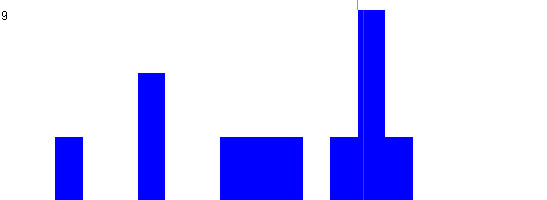
To compose with the JCself- machine you’ll find under Options, Setup State Machine, Main
- Cascade effects
- Loop Effects
- Speed Effect
- Transposition
- Melody Effects
All these effects are initiated by JCself through the following stochastic method. If a given number of events have taken place, the above mentioned effects are initiated. The event concerned, here, means a term from the parallel sequence which appears in the “number of choices”
If you insert a figure into the window “field” this figure encloses the number of elements from the so called “number of choices” JCself chooses “number of choices” from the amount of “parallel sequences” at random, though. Reaching a given number of the repetition of the highest term/value (or any term/value of the amount) the above mentioned effects are initiated by JCself and additional material is incorporated into the sequence of tones.
Annotations: Stochastic development is influenced by activating Status Bar. Tones which JCself has figured out through Status Bar have the highest chance to be repeated.
Cascade effects mean a sequence of tones at regular intervals and in the same direction. An interval can be determined with the button/window one step up and one step down. The figure to be inserted here describes the number of semitones which add up to the interval. In the window number you determine the number of “steps”.
With loop effects the repetition of a definite sequence of tones generated by JCself is labled. The number of tones to be repeated has to be put into loop depth the number of repetitions into loop repeats
When activating permutation only the pitches of the tones are repeated and put onto the other qualities of tones . The latter remain unchanged in their morphology.
If you activate do loop bug an error in the running program is activated, the origin and consequences of which was not detected. Nils Kay and Peter Heeren regarded the results of those mistakes as beautiful, though, and didn’t want to deny other composers this experience. But they do not accept responsibility if this possibility is used.
Speed Effect embrace all alterations of tempo. The scale of tempo variations is defined by Min.Tempo and Max. Tempo. The figure inserted indicates the meter value according to Mälzel. “Mälzel” measuring units also depict the change of tempo. Whether this term is added or subtracted is random.
Activating transposition transposes the tones JCself has calculated. The figure to be inserted stipulates the scale of semi-tones within which the transposition shall take place. If you put 4 into plus notes, for instance, it means that JCself either transposes with a minor second lifted (1), a major second lifted (2) or minor (3) or major thirds lifted (4) but at random. This transposition lasts until a further triggering off. The latter then indicates a new transposition with the interval given, starting from the previous setting. The window Minus notes acts respectively.
If transposed tones are outside the given scale of frequencies they are deleted by JCself.
Note: JCself saves the original figure/value of the probability dispersion.
JCself composes to its sequence of tones a melody if you activate melody effects. (But this is only possible if the function melody effects is activated together with 12 tempered notes. Independent figures can be put into amount/number and threshold value.
Annotations: A melody tone is kept until the next one is initiated. (The figure in prolongation refers to the melody tone, too. It is prolonged, as well).
Note: only that melody tone can be chosen which relates to the basic tone in the intervals Prime, minor/major Thirds and minor/major Sixths.
From the shadow sequence (!) the difference between the highest value, so far, and the topical value is calculated. It is ordered then and divided up into 6 parts which are assigned to an interval each.
Tones which are located towards each other in the smallest intervals possible – the so called horizontal line - form the melody.
The scale of tones that form the melody is limited in its range.
With the 8th Instrument the colour of the melody tone (timbre) is manifested.
Shadow generation creates the volumes of the melody tones and a retardation of a tone begins, too, in relation to the basic tone. The closer the topical value/figure is to the topical highest value/figure the smaller is this retardation.